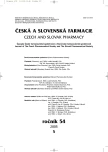Ouabain: from an Arrow Poison to a New Steroidal Hormone
Authors:
P. Mučaji; M. Nagy; D. Grančai
Authors‘ workplace:
Farmaceutická fakulta Univerzity Komenského v Bratislavě, Katedra farmakognózie a botaniky, SR
Published in:
Čes. slov. Farm., 2005; 54, 207-210
Category:
Review Articles
Overview
For more than 200 years, cardiotonic glycosides have been used for the treatment of congestive heart failure. Ouabain is a well-known arrow poison obtained from different Acokanthera or Strophanthus species. Much information has now accumulated that this plant toxin and its congeners are mammalian steroid hormones involved in the pathophysiology of cardiovascular diseases. There is an interesting fact that 50% patients with essential hypertension have elevated levels of endogenous ouabain. A better knowledge of the interactions of these compounds with the hormones of salt and water metabolism might help to improve the diagnosis and therapy of hypertension.
Key words:
ouabain – cardioglycosides – steroid hormones
Labels
Pharmacy Clinical pharmacologyArticle was published in
Czech and Slovak Pharmacy

2005 Issue 5
Most read in this issue
- The Development of the Composition of Castellan’s Solution
- Ouabain: from an Arrow Poison to a New Steroidal Hormone
- Blockers of β-Adrenergic Receptors – a Group of Chiral Agents Stereoselective Synthesis of β-Blockers
- Dimethindene Determination in Various Dosage Forms by Means of Capillary Isotachophoresis
